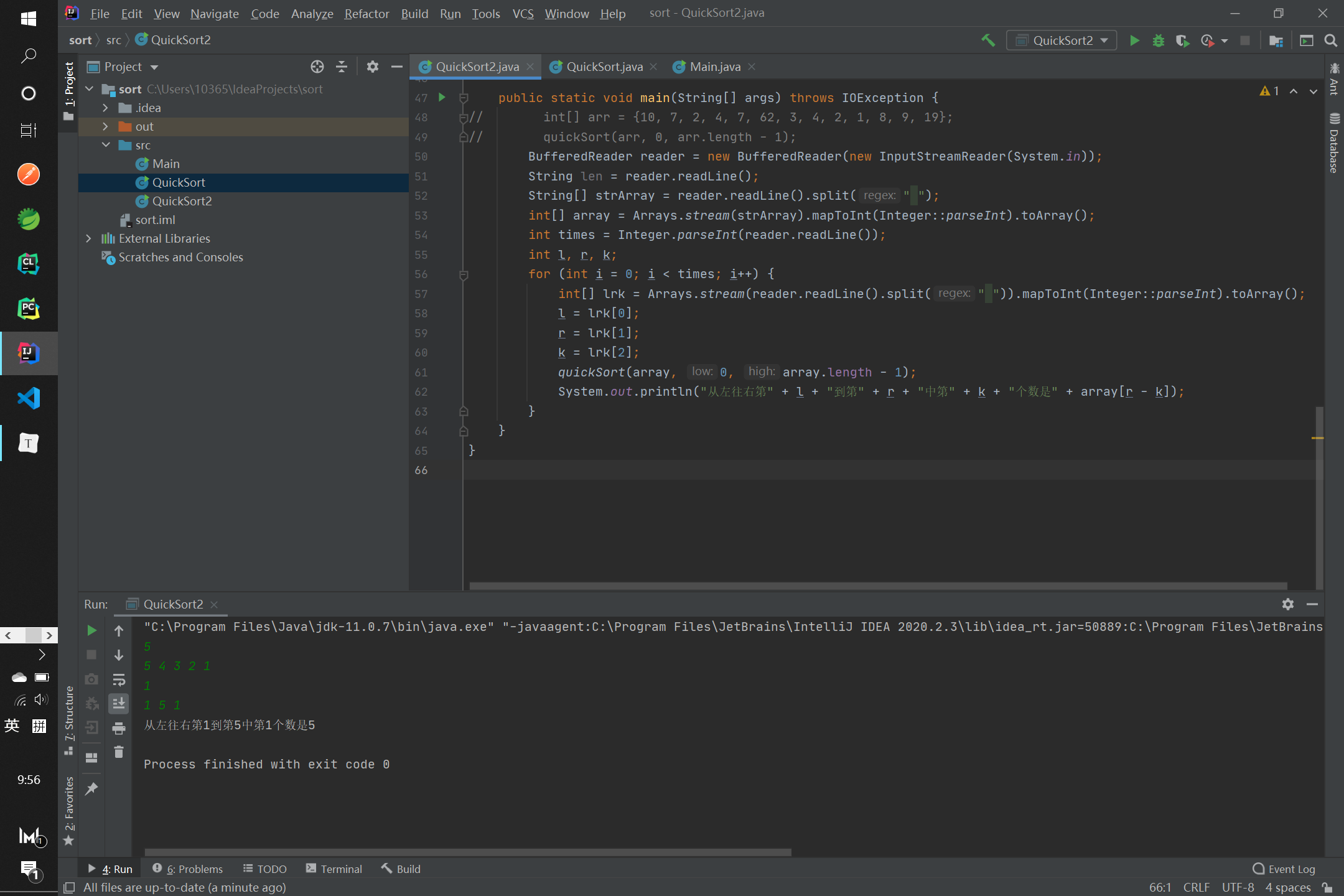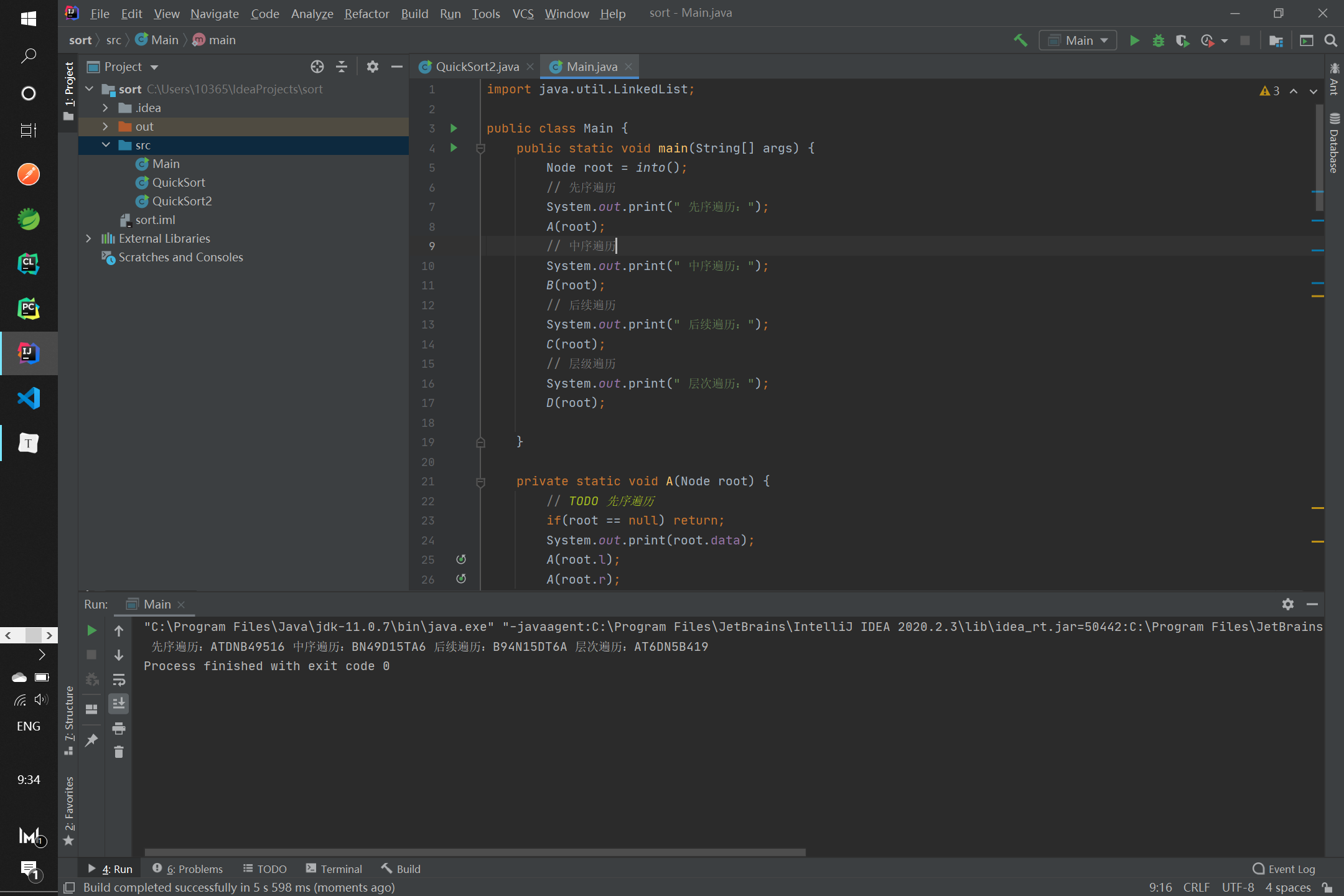2020软件工程作业04
| 这个作业属于哪个课程 | https://edu.cnblogs.com/campus/zswxy/2018SE/ |
|---|---|
| 这个作业要求在哪里 | https://edu.cnblogs.com/campus/zswxy/2018SE/homework/11406 |
| 这个作业的目标 | 实现算法 |
| 其他参考文献 | ... |
快速排序
思路:
- 从数列中挑出一个元素,称为"基准"(pivot)
- 重新排序数列,所有元素比基准值小的摆放在基准前面,所有元素比基准值大的摆在基准的后面(相同的数可以到任一边)。在这个分区结束之后,该基准就处于数列的中间位置。
- 递归把小于基准值元素的子数列和大于基准值元素的子数列排序。
import java.io.BufferedReader;
import java.io.IOException;
import java.io.InputStreamReader;
import java.util.Arrays;
/**
* Created by HeHao on 2020/10/28 10:51
*/
public class QuickSort {
public static void quickSort(int[] arr, int low, int high) {
int i, j, temp, t;
if (low > high) {
return;
}
i = low;
j = high;
//temp就是基准位
temp = arr[low];
while (i < j) {
//先看右边,依次往左递减
while (temp <= arr[j] && i < j) {
j--;
}
//再看左边,依次往右递增
while (temp >= arr[i] && i < j) {
i++;
}
//如果满足条件则交换
if (i < j) {
t = arr[j];
arr[j] = arr[i];
arr[i] = t;
}
}
//最后将基准为与i和j相等位置的数字交换
arr[low] = arr[i];
arr[i] = temp;
//递归调用左半数组
quickSort(arr, low, j - 1);
//递归调用右半数组
quickSort(arr, j + 1, high);
}
public static void main(String[] args) throws IOException {
// int[] arr = {10, 7, 2, 4, 7, 62, 3, 4, 2, 1, 8, 9, 19};
// quickSort(arr, 0, arr.length - 1);
BufferedReader reader = new BufferedReader(new InputStreamReader(System.in));
String len = reader.readLine();
String[] strArray = reader.readLine().split(" ");
int[] array = Arrays.stream(strArray).mapToInt(Integer::parseInt).toArray();
int times = Integer.parseInt(reader.readLine());
int l, r, k;
for (int i = 0; i < times; i++) {
int[] lrk = Arrays.stream(reader.readLine().split(" ")).mapToInt(Integer::parseInt).toArray();
l = lrk[0];
r = lrk[1];
k = lrk[2];
quickSort(array, 0, array.length - 1);
System.out.println("从左往右第" + l + "到第" + r + "中第" + k + "个数是" + array[r - k]);
}
}
}

二叉树遍历
四种主要的遍历思想为:
-
先序遍历:根结点 —> 左子树 —> 右子树
-
中序遍历:左子树—> 根结点 —> 右子树
-
后序遍历:左子树 —> 右子树 —> 根结点
-
层次遍历:只需按层次遍历即可
import java.util.LinkedList;
/**
* Created by HeHao on 2020/10/28 10:51
*/
public class Main {
public static void main(String[] args) {
Node root = into();
// 先序遍历
System.out.print(" 先序遍历:");
A(root);
// 中序遍历
System.out.print(" 中序遍历:");
B(root);
// 后续遍历
System.out.print(" 后续遍历:");
C(root);
// 层级遍历
System.out.print(" 层次遍历:");
D(root);
}
private static void A(Node root) {
// TODO 先序遍历
if (root == null) return;
System.out.print(root.data);
A(root.l);
A(root.r);
}
private static void B(Node root) {
// TODO 中序遍历
if (root == null) return;
B(root.l);
System.out.print(root.data);
B(root.r);
}
private static void C(Node root) {
// TODO 后续遍历
if (root == null) return;
C(root.l);
C(root.r);
System.out.print(root.data);
}
private static void D(Node root) {
// TODO 层级遍历
if (root == null) return;
LinkedList<Node> linkedList = new LinkedList<>();
Node current = null;
//将根节点入队
linkedList.offer(root);
while (!linkedList.isEmpty()) {
//出队队头元素并访问
current = linkedList.poll();
System.out.print(current.data);
//如果当前节点的左节点不为空入队
if (current.l != null) {
linkedList.offer(current.l);
}
//如果当前节点的右节点不为空,把右节点入队
if (current.r != null) {
linkedList.offer(current.r);
}
}
}
// 构建一颗树,返回根节点
private static Node into() {
Node root = new Node("A");
Node node1 = new Node("T");
Node node2 = new Node("D");
Node node3 = new Node("N");
Node node4 = new Node("B");
Node node5 = new Node("6");
Node node6 = new Node("5");
Node node7 = new Node("4");
Node node8 = new Node("9");
Node node9 = new Node("1");
root.l = node1;
node1.l = node2;
node2.l = node3;
node2.r = node6;
node3.r = node7;
node7.r = node8;
node6.l = node9;
node3.l = node4;
root.r = node5;
return root;
}
// 节点
static class Node {
// 数据
Object data;
// 左孩子
Node l;
// 右孩子
Node r;
public Node() {
}
public Node(Object data) {
this.data = data;
this.l = null;
this.r = null;
}
public Node(Object data, Node l, Node r) {
this.data = data;
this.l = l;
this.r = r;
}
}
}
